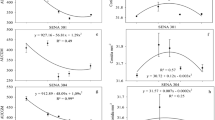Abstract
Oospore production inPeronospora farinosa f. sp.spinaciae was induced in spinach seedlings. This was done in detached cotyledons as wel as in undetached cotyledons on living plants, and in growth chambers as well as in the field. In young leaf tissue the fungus, produced oospores more often than in old tissue. The four spinach cultivars tested, viz. Breedblad Scherpzaad, Symphony, Novires and Huro, did not show significant differences in numbers of cotyledons with oospores, nor in numbers of oospores per cotyledon, though cv. Breedblad Scherpzaad was less susceptible to oospore formation in the field. Comparison of various inoculum densities showed a tendency to a smaller number of cotyledons with oospores with a lower inoculum density. Oospores were abundantly formed, when the plants were exposed to stress conditions in the second half of the latent period.
Samenvatting
Methoden werden ontwikkeld om oosporenvorming doorPeronospora farinosa f. sp.spinaciae in kiemplanten van spinazie te induceren. Dit gebeurde met afgeplukte kiembladeren en in kiembladeren aan de levende plant, zowel in klimaatcellen als tevelde.
In jonge kiembladeren werden vaker en meer oosporen gevormd, dan in oudere kiembladeren. De vier getoetste cultivars Breedblad Scherpzaad, Symphony, Novires en Huro vertoonden geen opvallende verschillen in aantallen kiembladeren met oosporen en aantallen oosporen per kiemblad, hoewel cultivar Breedblad Scherpzaad in het veld als minst vatbaar voor oosporenvorming naar voren kwam.
Vergelijking van verschillende inoculum dichtheden toonde een tendens aan voor een kleiner aantal cotylen met oosporen bij lagere inoculumdichtheden. Er werden overvloedig oosporen gevormd wanneer de planten in de tweede helft van de latentieperiode in een ‘stress’ situatie werden gebracht.
Similar content being viewed by others
References
Berry, S.Z. & Davis, G.N., 1957. Formation of oospores byPeronospora destructor and their possible relation to epiphytology. Pl. Dis. Reptr 41: 3–6.
Bruyn, H.L.G. de, 1937. Heterothallism inPeronospora parasitica. Genetica 19: 553–557.
Butler, E.J. & Jones, S.G., 1961. Plant pathology. MacMillan & Co. Ltd., London, 979 pp.
Channon, A.G., 1981. Downy mildew ofBrassicae. In: D.M. Spencer (Ed.), The downy mildews. Academic Press, London, P. 321–339.
Cook, H.T., 1935. Occurence of oospores ofPeronospora effusa with commercial spinach seed. Phytopathology 25: 11–12 (Abstr.).
Fincham, J.R.S., Day, P.R. & Radford, A., 1979. Fungal genetics. Biological monographs, Volume 4. Blackwell Scientific Publications, Oxford, 300 pp.
Inaba, T. & Hino, T., 1980. Influence of water and temperature on oogonium and oospore formation of downy mildew fungus,Peronospora manshurica, in soybean lesions. Ann. phytopath. Soc. Japan 46: 480–486.
McMeekin, D., 1960. The role of the oospores ofPeronospora parasitica in downy mildew of crucifers. Phytopathology 50: 93–97.
Melhus, I.E. & Patel, M.K., 1929. Study ofPeronospora trifoliorum Debary on species ofLeguminosae. Proc. Iowa Acad. Sci. 36: 113–119.
Michelmore, R.W. & Ingram, D.S., 1980. Heterothallism inBremia lactucae. Trans Br. mycol. Soc. 75: 47–56.
Norwood, J.M. & Crute, I.R., 1983. Infection of lettuce by oospores ofBremia lactucae. Trans Br. mycol. Soc. 81: 144–147.
Pawlik, A., 1961. Zur Frage der Überwinterung vonPeronospora tabacina Adam. Beobachtungen über Oosporenkeimung. Z. PflKrankh. PflPath. PflSchutz 68: 193–197.
Pegg, G.F. & Mence, M.J., 1970. The biology ofPeronospora viciae. on pea: laboratory experiments on the effects of temperature, relative humidity and light on the production, germination and infectivity of sporangia. Ann. appl. Biol. 66: 417–428.
Populer, C., 1981. Epidemiology of downy mildews. In: Spencer, D.M., (Ed.), The downy mildews. Academic Press, London, P. 57–105.
Snedecor, G.W. & Cochram, W.G., 1980. Statistical methods. The Iowa State University Press, Ames, 507 pp.
Wright, C.M. & Yerkes, W.D., Jr., 1950. Observations on the overwintering of the pathogen causing downy mildew of spinach in the Walla-Walla area. Pl. Dis. Reptr 34: 28.
Zadoks, J.C. & Schein, R.D., 1979. Epidemiology and plant disease management. Oxford University Press, New York and Oxford, 427 pp.
Author information
Authors and Affiliations
Rights and permissions
About this article
Cite this article
Frinking, H.D., Harrewijn, J.L. & Geerds, C.F. Factors governing oospore production by Peronospora farinosa f. sp. spinaciae in cotyledons of spinach. Netherlands Journal of Plant Pathology 91, 215–223 (1985). https://doi.org/10.1007/BF01997965
Accepted:
Issue Date:
DOI: https://doi.org/10.1007/BF01997965




